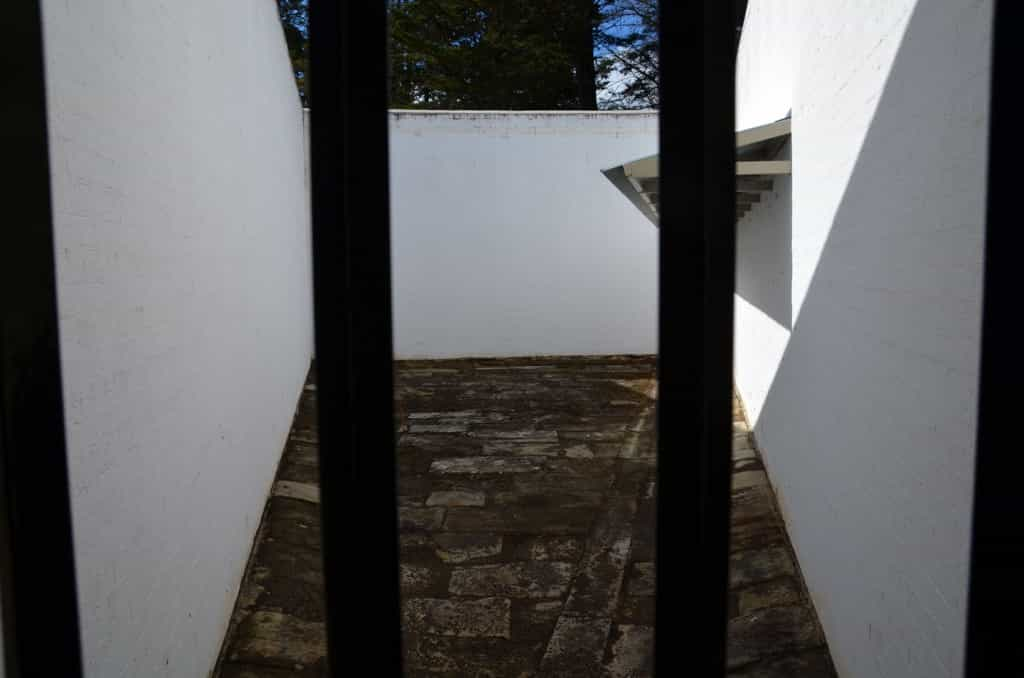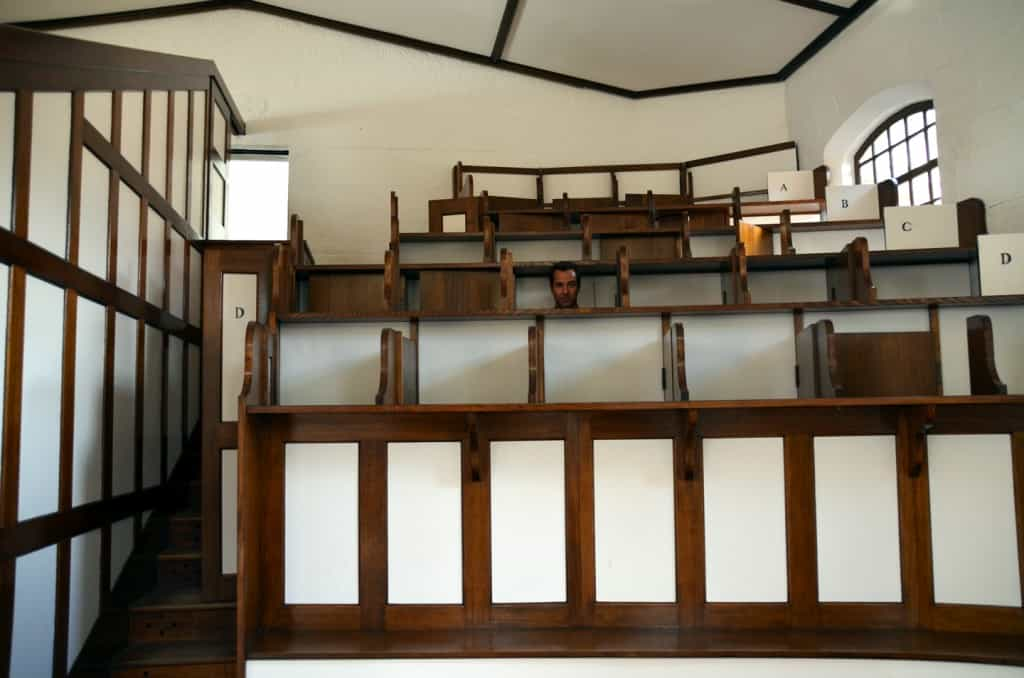After two weeks on the road in New-Zealand, we landed in Tasmania, intent on spending 4 nights in a nice hotel, with the occasional day trip outside the city.
The easiest one involved a short, if tortuous, drive up Mount Wellington, where you get a stunning, above the clouds view of Hobart.
While New-Zealand is charming and easy going, “sophisticated” is not an attribute that often comes to mind. Tasmania being so… out of the way, with a population roughly equal to that of New-Zealand, one could expect certain similarities. One would be wrong. Hobart is not a big place, but the centre of the city and the waterfront are very refined neighbourhoods, with a wide array of shops, fine dining options and lots of beautiful people. After all, any city boasting “drinking consultants” is bound to make a dashing impression on me.
January 2011, marked the completion of the Museum of Old and New Art (MONA) in Hobart. We did not expect much going, even though we were told it was THE thing to visit in Hobart. After being surprised by the 45 min wait to get in on a weekday morning, we were stunned by the museum. Mostly built underground, it hosts a variety of interesting creations, old and new, such as this gothic cement truck!
Even the parking is provocative. Since pictures are often prohibited in museums, I did not bother to bring my camera with me (except my little point-and-shoot). Big mistake. We stumbled upon one of the most original creations I have ever seen. “bit.fall” is an artificial waterfall that works a like an inkjet printer, “writing” letters of water in mid-air. I would have needed my camera to capture properly, but you can check it out on youtube.
A little by chance, I took two pictures near my hotel which illustrate how timing can be everything when travelling. This is Salamanca Street on a Sunday morning.
And on a Saturday morning! Market day is only once a week and is enormously popular among tourists and locals alike. Arts and crafts and musicians abound (including the city’s Pipes and Drums band).
Uninterested in shopping, I focused on food. This little stand had a mustard like none I have ever tasted. Never before have I been satisfied about a mustard being hot enough. For the first time ever, I had to open my sandwich and, with tears in my eyes, scrape some of it off. It was insane. From breathing while chewing, I could feel the burn in my windpipe!
Having been around the city core, we headed south, trying not to add to the piles of road kill along the way. This sign warns of tasmanian devils crossing. Having grown up watching the Bugs Bunny Show, it would have been clearer for me had the sign shown a little tornado with claws sticking out of it, but no matter. Sadly, tasmanian devils are threatened with extinction. You would think that Tasmanians would spare no efforts to save such a unique national symbol, but the reality is that they do not know what to do. The species is experiencing an unexplained epidemic of communicable cancers called devil facial tumour disease. Healthy animal are currently being quarantined to insure the survival of the specie, should they die out in the wild.
After driving a camper van with a third of a million kilometres across the curvy and hilly roads of New-Zealand, driving this little thing with less than 4,000 km around Australia felt like the Indy 500. I could perform such incredible feats as accelerating while driving uphill! Of course, neither of our suitcases could fit in the trunk, but life is all about compromises.
As you may have heard on the news, Tasmania, and parts of mainland Australia, suffered severe fires in January. We were in the heart of it – although things were under control by the time we showed up.
From a distance, it almost looked like Eastern Canada in the Fall. As it turns out, these leaves have not merely ceased to produced chlorophyl, they have been “cooked” by the brushfires.
Looking closely, you can see the kind of heat that the burning grass must have generated to have such an effect on the trees. I wonder what conditions cause a brush fire with such an effect, compared to what we call forest fires back home, where the entire tree goes up in flames. While I believe loss of life was limited to a single elderly man who perished in his home, scores were left homeless. We drove through a small village where at least a dozen houses had burned to the ground. We were surprised at the seemingly random distribution; with a pile of ashes between two intact houses. Perhaps the efforts locals put in defending their own homes or small, but critical differences in the surrounding vegetation? I did not have it in me to stop for pictures in front of the villagers.
While these devastating fires are certainly no laughing matter, we did laugh a bit at ourselves. On the first morning, we awoke to an acrid smell of smoke. Walking to the nearest cafe, we were surprised to find a significant amount of smoke in the street, to the point of slightly reducing visibility. We assumed winds had changed direction and smoke from the neighbouring countryside was being carried vast distances into the city. As it turns out, this store, three blocks away from the hotel, was on fire!
During our short stay in Tasmania, our only significant road trip involved going to the old penal colony of Port Arthur, about an hour and a half away. This facility would have been the equivalent at the time of a maximum security prison, and all 7,000 prisoners who served time there were repeat offenders. This is a small proportion of the 165,000 condemned criminals deported to Australia or, as they called it at the time “transported” (judges would sentence you to “transportation” for 8 years, 15 years, life, etc). Kids as young as 9 were transported there (in early 19th Century Britain, you were responsible for your acts by age 7 and could be sentenced to execution by age 8). Ironically for a maximum security facility, there were no fences or anything else preventing you from walking away when you were not in the buildings. The security came from the fact that there was nowhere to go to.
The site is on a peninsula and detainees would have been transported by boat and not be aware of what was in which direction. If they attempted to walk towards Hobart, they would have gone through a narrow passage and likely been caught by soldiers who would have long been warned by semaphore that a prisoner had escaped. Many who escaped eventually came back, exposed to the elements with nothing to eat and nowhere to go. Some were never heard of again, but it is difficult to know if some attempts were successful or if they merely perished in the wilderness.
The bush fires that raged the week before our arrival are nothing new to the region and the church, just like the main penitentiary building, have long been destroyed by fire. Prisoners were allowed to practice Catholicism as well as Protestantism, but some sort of church attendance was encouraged, as a means of reform and rehabilitation. Hard work was also encouraged as the path to self-improvement and the prison eventually built an impressive level of industrial output, in such areas as lumber and even ship building.
For repeat offenders who couldn’t manage to behave, a special penitentiary was built. This was revolutionary thinking at the time. Prisoners used to be packed in large numbers in insalubrious prisons, mainly with an intent of punishment and deterrence. In penitentiaries, inmates would be isolated in individual cells and left, or so the idea was, to reflect upon their behaviour and repent. In this facility, they would not be allowed any contact with other inmates. They spent 23 hours a day in their cells and when a guard had to enter, or when they had to leave, they wore the mask you see hanging on the wall, to prevent any non-verbal communication.
The hour outside the cell was spent, alone, walking around this exercise yard. This type of isolation and sensory deprivation gradually replaced the whip and other forms of corporal punishments of the past.
The special penitentiary had its own church and even there, detainees were isolated from each other. Eventually, the prison closed in 1877.
While searching online for that very date, I came upon a fact I had long forgotten. Port Arthur was the site of the 1996 mass murder which led to the massive reforms of Australian gun laws. A mentally retarded 29 year old man, Martin Bryant, opened fire on tourists, killing 35 and injuring 21. He was caught by police on the scene and is currently serving 35 life sentences, plus 1,035 years without parole.
#Australia


















Just came across an entry from David Byrne’s blog on MONA. The comparison to the building being like the lair of a villain in a Bond film is spot on. He also details the MONA GPS…I forgot all about that part. http://journal.davidbyrne.com/2013/01/012113-monaism.html
Pingback: Celebrating the Renaissance and visiting submarines in the vast plains of Oklahoma! | Colin’s Notes